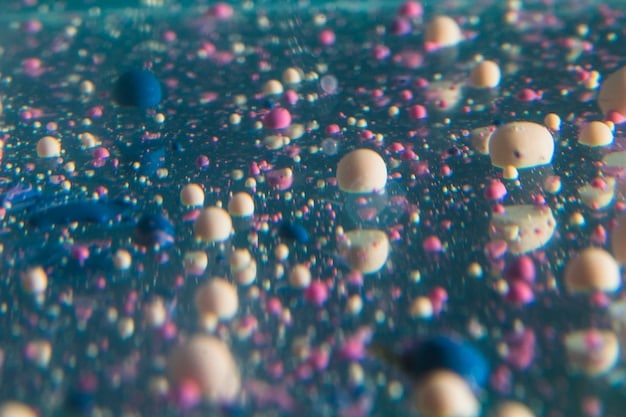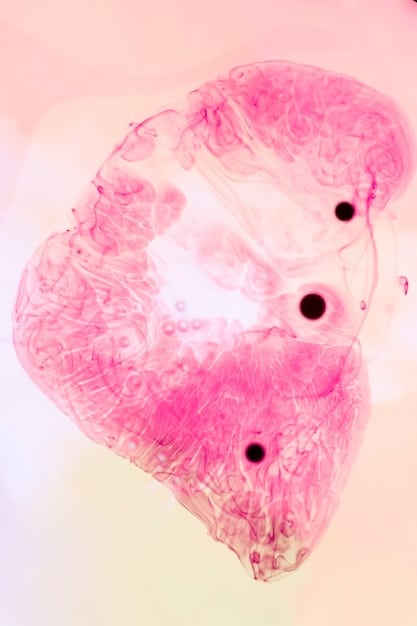Microplastics: Health Risks, Latest Research, and Minimizing Exposure

Advertisements
The latest research on microplastics reveals growing concern over their pervasive presence in the environment and human body, prompting investigation into potential health risks and methods for minimizing exposure.
Advertisements
In an increasingly interconnected world, the intricate dance between human activity and environmental impact comes into sharper focus. One of the most ubiquitous, yet often unseen, challenges of our modern age involves microplastics. Understanding the Latest Research on Microplastics: What are the Health Risks and How Can We Minimize Exposure? is no longer just an academic exercise but a pressing global imperative as scientists increasingly uncover their presence in surprising places, including our own bodies.
The Pervasive Presence of Microplastics
The journey to understanding microplastics begins with grasping their environmental ubiquity. These tiny plastic fragments, less than 5 millimeters in length, originate from a myriad of sources, ranging from the breakdown of larger plastic debris to microbeads used in personal care products and synthetic clothing fibers. Their minute size allows for easy dispersion throughout ecosystems, becoming an integral, albeit unwanted, component of our natural world. This widespread dispersion makes them a truly global contaminant, reaching even the most remote corners of the planet.
Advertisements
Sources and Pathways of Microplastic Pollution
Microplastics enter the environment through various pathways. Primary microplastics are manufactured directly for specific uses, such as abrasive cleaning agents or pre-production plastic pellets. Secondary microplastics, far more common, result from the fragmentation of larger plastic items like bottles, bags, and fishing nets, degraded by environmental factors such as UV radiation, wind, and waves.
- Wastewater Effluents: A significant pathway for microplastic delivery into aquatic environments, carrying fibers from synthetic clothing washed in laundry and microbeads from cosmetics.
- Agricultural Runoff: Plastics used in agriculture, such as mulching films and irrigation pipes, degrade over time, releasing microplastics into soils that can then be transported to water bodies.
- Atmospheric Deposition: Airborne microplastic particles can travel long distances before settling onto land or water surfaces, contributing to pollution far from their source.
Understanding these pathways is crucial for developing targeted strategies to mitigate their entry into the environment. The sheer volume of plastic produced globally means that even a small percentage of degradation translates into astronomical numbers of microplastic particles.
We find microplastics in oceans, freshwater systems, soil, and even the air we breathe. Their presence across such diverse environments underscores the scale of the challenge. From the Mariana Trench, the deepest oceanic point, to the peaks of the Pyrenees, microplastics demonstrate an alarming ability to colonize every habitat. This pervasive presence means that contact with these particles is practically unavoidable for most living organisms, including humans, raising urgent questions about the potential implications for health. The challenge lies not only in stopping future contamination but also in addressing the vast existing reservoir of these minuscule pollutants.
Unraveling the Health Risks: Latest Scientific Findings
The scientific community has intensified its focus on understanding the potential health implications of microplastic exposure. While direct, undeniable causal links between microplastic exposure and specific human diseases are still being actively researched and established, emerging evidence from in vitro studies, animal models, and preliminary human observations points to several concerning possibilities. The complexity of this research stems from the varied nature of microplastics themselves, which differ in size, shape, chemical composition, and adsorbed contaminants.
Mechanisms of Entry and Internal Distribution
Humans are exposed to microplastics primarily through ingestion, inhalation, and dermal contact. Ingestion occurs through contaminated food and water, including seafood, salt, and bottled water. Inhalation happens when airborne microplastics, often shed from textiles and other consumer products, are breathed in. Dermal exposure, though less studied, may occur through direct contact with microplastic-laden products or environments. Once inside the body, the fate of microplastics depends largely on their size and shape. Smaller particles, particularly nanoplastics (even tinier particles, less than 1 micrometer), are of greater concern due to their potential to cross biological barriers.
- Gastrointestinal Tract: The most common entry point for ingested microplastics. Some pass through and are excreted, while smaller ones may penetrate the gut lining.
- Lungs: Inhaled microplastics can deposit in the respiratory tract. Larger particles might be expelled, but smaller ones could potentially reach the alveoli.
- Bloodstream and Organs: Emerging evidence suggests nanoplastics can translocate from the gut or lungs into the bloodstream, potentially reaching distant organs like the liver, kidneys, brain, and even the placenta.
The potential for systemic circulation of these particles is a major concern, as it implies a widespread exposure throughout the body, not just at the point of entry.
Researchers are exploring various potential biological effects. These include physical impacts, such as inflammation and oxidative stress caused by the particles themselves. There is also concern about the chemicals added during plastic manufacturing (e.g., plasticizers, flame retardants) which can leach out. Furthermore, microplastics can adsorb environmental contaminants like heavy metals and persistent organic pollutants, acting as vectors for their transport into the body. These combined effects, mechanical, chemical, and as transporters, create a complex challenge for toxicology research. Much of the current understanding draws from animal studies and cellular models, highlighting the need for more extensive human epidemiological research.
Chemical Additives and Their Role in Toxicity
The inherent toxicity of microplastics is not solely attributable to the physical presence of the particles themselves, but also profoundly linked to the vast array of chemical additives incorporated during their manufacturing process. These chemicals are introduced to provide plastics with specific properties — flexibility, flame resistance, color, and durability. However, many of these same additives are known endocrine disruptors, carcinogens, or have other adverse health effects when released into the environment or inside living organisms.
Common Additives and Their Potential Effects
Plastic production relies on a complex cocktail of chemicals. Phthalates, for instance, are widely used as plasticizers to make plastic flexible, found in everything from food packaging to children’s toys. Bisphenol A (BPA) is another well-known chemical used in polycarbonate plastics and epoxy resins. Brominated flame retardants (BFRs) are added to reduce flammability in electronics and textiles.
- Phthalates: Linked to reproductive issues, developmental problems, and metabolic disruption. They are frequently found in PVC plastics.
- Bisphenol A (BPA): A known endocrine disruptor, mimicking estrogen, which has been associated with reproductive disorders, obesity, and certain cancers.
- Brominated Flame Retardants (BFRs): Can interfere with thyroid function and have neurodevelopmental effects. They persist in the environment and bioaccumulate.
These chemicals are not permanently bound within the plastic matrix. Over time, and particularly under environmental stressors like heat, UV radiation, or even changes in pH, these additives can leach out, becoming bioavailable. When microplastics enter the body, a similar leaching process can occur, releasing these harmful chemicals directly into biological systems. The concern is amplified by the fact that microplastics can act as ‘Trojan horses,’ delivering these chemicals to tissues and organs where they might not otherwise accumulate.
Beyond manufacturing additives, microplastics also have a high affinity for adsorbing pollutants already present in the environment such as pesticides, heavy metals, and persistent organic pollutants (POPs). This phenomenon means that a microplastic particle ingested by an organism might not only be a physical irritant but also a mobile delivery system for a range of additional toxins. The cumulative effect of internal exposure to both intrinsic plastic additives and adsorbed environmental contaminants represents a significant and under-researched area of health risk. This complex interplay underscores the multi-faceted nature of the microplastic health challenge.
Impact on Biological Systems: From Cells to Organs
The journey of microplastics within the body, from their entry points to potential interactions at the cellular and organ level, is a critical area of ongoing scientific inquiry. While comprehensive human epidemiological data remains a developing field, laboratory studies using cell cultures and animal models are providing initial insights into how these minuscule particles might disrupt normal biological functions. The effects appear to be multi-faceted, ranging from physical irritation to complex biochemical alterations.
Cellular and Immune Responses
At the most fundamental level, microplastics can interact directly with cells. Studies have shown that cells exposed to microplastics can exhibit signs of stress, including oxidative damage. This occurs when there’s an imbalance between the production of free radicals and the body’s ability to detoxify them, leading to cellular damage. Such damage can precursor to various chronic diseases. Furthermore, the immune system often perceives these foreign particles as threats.
- Inflammation: Microplastics can trigger inflammatory responses, as the body attempts to encapsulate or remove the foreign material. Chronic inflammation is a known contributor to numerous health problems.
- Oxidative Stress: Exposure can lead to an increase in reactive oxygen species, damaging cellular lipids, proteins, and DNA.
- Apoptosis and Necrosis: In some cases, high concentrations or specific types of microplastics have been observed to induce programmed cell death (apoptosis) or uncontrolled cell death (necrosis).
Beyond direct cellular damage, there’s concern about the impact on specific organs. Research indicates that ingested microplastics can potentially cross the gut barrier and enter the bloodstream, allowing for distribution to other organs. Studies in laboratory animals have found microplastics accumulating in the liver, kidneys, spleen, and even the brain, raising questions about their long-term effects on organ function. For instance, hepatic accumulation could impair liver detoxification pathways, while renal accumulation might affect kidney filtration processes.
The potential for microplastics to cross the blood-brain barrier is particularly alarming, suggesting neurotoxic possibilities, though this area requires extensive further investigation. Given the role of the gastrointestinal system as the primary point of entry for ingested particles, there is significant interest in how microplastics might alter the gut microbiome and impact gut barrier integrity, both of which are central to overall health and immune function. The implications for subtle, long-term disruptions to these vital systems remain a key focus of current and future research.

Minimizing Exposure: Practical Strategies for Individuals
While systemic and regulatory changes are crucial for tackling microplastic pollution on a grand scale, individuals also possess agency in minimizing their daily exposure. Adopting mindful consumption habits and making informed choices about products can contribute significantly to reducing both personal intake and the overall demand for plastics that generate microplastics. This involves a shift in perspective, recognizing that many everyday items contribute to the problem.
Conscious Consumption and Product Choices
The first step in minimizing exposure is to become a more discerning consumer. This means actively seeking alternatives to single-use plastics and scrutinizing product labels. For instance, avoiding personal care products that contain microbeads (often listed as polyethylene, polypropylene, or polymethyl methacrylate) is a direct way to reduce primary microplastic release into waterways. Similarly, opting for clothing made from natural fibers over synthetics can decrease fiber shedding during laundry cycles.
- Reduce Single-Use Plastics: Opt for reusable water bottles, coffee cups, shopping bags, and food containers. This directly lessens the production and subsequent degradation of plastic waste.
- Filter Tap Water: While municipal water undergoes treatment, some studies have detected microplastics in tap water. Consider using a water filter certified to remove microparticles.
- Choose Natural Fiber Clothing: Prioritize garments made from cotton, wool, linen, or hemp over polyester, nylon, and acrylic, which shed microfibers when washed. Wash synthetic clothes less frequently and consider using laundry bags designed to capture microfibers.
Beyond personal care and apparel, food packaging is a significant source of microplastic exposure. Plastics used in food containers and wraps can leach microplastics into food, especially when heated. Storing food in glass, ceramic, or stainless steel containers, and avoiding microwaving in plastic, are simple yet effective strategies to reduce ingestion. Similarly, being cautious about the type of seafood consumed, especially filter feeders, can also be a consideration, as these organisms can accumulate microplastics.
Ultimately, minimizing exposure involves a holistic approach to lifestyle choices. It’s about recognizing the omnipresence of plastics in our lives and consciously choosing options that reduce our personal footprint. While completely eliminating exposure is unrealistic given the pervasive nature of microplastics, every small step contributes to a cumulative reduction and awareness, empowering individuals to be part of the solution rather than just being exposed to the problem.
Systemic Solutions: Policy, Innovation, and Research
Addressing the global microplastic challenge requires much more than individual actions; it demands systemic solutions driven by comprehensive policy, groundbreaking innovation, and continuous research. Governments, industries, and academic institutions must collaborate to create a future where plastic pollution is minimized at its source and effectively managed throughout its lifecycle. This multi-pronged approach is essential for long-term, sustainable impact.
Governmental Policies and Industry Innovations
Effective governmental policies are the backbone of large-scale change. Bans on single-use plastics, regulations on industrial plastic waste, and mandates for sustainable product design are critical. Several countries and regions have already implemented bans on microbeads in personal care products, setting a precedent. Broader policies targeting plastic packaging, such as extended producer responsibility (EPR) schemes where manufacturers are responsible for the entire lifecycle of their products, incentivize sustainable design and recycling infrastructure.
- Source Reduction: Policies that promote reducing plastic production, especially virgin plastic, and encourage the use of alternative materials.
- Improved Waste Management: Investing in robust recycling infrastructure, efficient wastewater treatment plants, and preventing plastic litter from entering the environment.
- Product Redesign: Encouraging industries to innovate and design products that are biodegradable, easily recyclable, or made from non-plastic materials, and eliminating unnecessary plastic components.
Innovation from the private sector is equally vital. This includes developing new, biodegradable materials that truly break down without leaving harmful microplastic residues. Companies are also exploring advanced recycling technologies that can process mixed plastic waste more efficiently, turning it back into raw materials. Furthermore, innovations in filtration technologies for wastewater treatment plants are crucial for capturing microplastics before they enter aquatic ecosystems. The burgeoning field of “green chemistry” also holds promise for developing safer plastic alternatives and less toxic additives.
Beyond policy and innovation, continued scientific research plays a foundational role. Understanding the full spectrum of microplastic health impacts, identifying new sources, and developing effective remediation strategies all depend on robust, collaborative research efforts. This includes epidemiological studies on human populations, breakthroughs in detection and quantification methods, and studies on socio-economic aspects of plastic consumption. The interplay of policy, industry, and science offers the most promising path forward in mitigating this pervasive environmental and health threat.

The Future Landscape: Predictions and Ongoing Challenges
Peering into the future of microplastic research and mitigation efforts reveals a landscape fraught with challenges but also illuminated by growing awareness and scientific advancement. The pervasive nature of microplastics means we are dealing with a legacy pollutant, yet understanding its dynamics allows for more targeted predictions and proactive measures. The trajectory of this environmental concern will be shaped by the interplay of scientific discovery, technological innovation, and global policy shifts.
Emerging Research Avenues and Collaborative Action
Future research is expected to delve deeper into the long-term health effects of chronic, low-level microplastic exposure, moving beyond acute toxicology studies. Of particular interest is the investigation into nanoplastics, which, due to their incredibly small size, present unique challenges for detection and a higher potential for cellular penetration and systemic distribution. Researchers will likely focus on large-scale epidemiological studies to establish clearer links between human health outcomes and various types and levels of microplastic exposure. The role of the gut microbiome in processing or being affected by microplastics also represents a burgeoning field of inquiry.
- Nano-Scale Toxicology: Focusing on the health implications and physiological pathways of ultrafine nanoplastics.
- Biodegradation Solutions: Researching new enzymes or microorganisms capable of effectively breaking down different types of plastic polymers safely.
- Circular Economy Models: Detailed studies on the implementation and effectiveness of circular economy principles in reducing plastic waste and microplastic generation.
The overarching challenge remains the sheer volume of plastic production and consumption. Despite efforts to reduce, reuse, and recycle, global plastic output continues to rise, exacerbating the problem. Economic incentives favoring virgin plastic over recycled materials, and the inertia of widespread consumer habits, pose significant hurdles. Furthermore, managing existing microplastic pollution in oceans and landfills presents monumental technical and logistical challenges. Developing cost-effective, scalable solutions for environmental remediation is a critical, ongoing endeavor.
However, the future is not without hope. Growing public awareness, coupled with increasing political will, is fueling momentum for change. International collaborations, such as global treaties aimed at plastic pollution, offer a framework for coordinated action. Investment in green technologies, such as advanced filtration systems and sustainable material science, is increasing. While eradicating microplastics entirely may be an impossible task, a future with significantly reduced plastic pollution and mitigated health risks is a tangible goal, driven by continued research and a collective commitment to environmental stewardship.
| Key Point | Brief Description |
|---|---|
| 🌊 Microplastic Ubiquity | Tiny plastic particles are widespread in oceans, air, and soil, originating from various sources. |
| 🔬 Health Concerns | Potential risks include inflammation, oxidative stress, and chemical leaching from plastic additives. |
| 🌱 Minimize Exposure | Reduce single-use plastics, choose natural fibers, filter water, and store food in non-plastic containers. |
| 🌍 Systemic Solutions | Requires policy changes, industry innovation, and continued research for global impact. |
Frequently Asked Questions About Microplastics
▼
Microplastics are tiny plastic particles, typically less than 5 millimeters in size. They originate from the breakdown of larger plastic debris (secondary microplastics) or are intentionally manufactured as small particles (primary microplastics), found in products like industrial abrasives and some personal care items. Synthetic textiles also shed microfibers during washing.
▼
Microplastics enter the human body primarily through ingestion and inhalation. We ingest them via contaminated food (e.g., seafood, salt, bottled water) and drinks. Inhalation occurs when airborne microplastic particles, often shed from clothing and household items, are breathed in. Dermal absorption is also a potential, though less studied, pathway.
▼
Current research suggests potential health risks include inflammation, oxidative stress, and physical damage to tissues. Additionally, microplastics can leach chemical additives (like BPA and phthalates) or adsorb environmental toxins, acting as carriers of harmful substances into the body. Long-term effects are still under investigation, emphasizing the need for ongoing research.
▼
Given their pervasive presence in the environment, completely avoiding microplastic exposure is challenging. However, individuals can significantly minimize their exposure by making conscious choices. These include reducing reliance on single-use plastics, using water filters, opting for natural fiber clothing, and storing food in non-plastic containers.
▼
Addressing microplastic pollution requires systemic solutions. This includes governmental policies like plastic bans and extended producer responsibility schemes, coupled with industry innovation in developing biodegradable materials and improving recycling technologies. Continued scientific research on health impacts and remediation methods is also crucial for long-term strategies. Collaborative action among all stakeholders is key.
Conclusion
The exploration into understanding the latest research on microplastics, their health risks, and how we can minimize exposure reveals a complex and evolving scientific landscape. While the full spectrum of their long-term health implications is still being meticulously uncovered, the pervasive presence of these particles, along with the potential for physical and chemical toxicity, presents a clear and pressing concern. Individuals can adopt practical strategies to reduce personal exposure, but the ultimate solution to this global challenge demands far larger, systemic changes. Through continued research, dedicated policy-making, and robust industrial innovation, coupled with an informed and engaged public, we can collectively work towards a future where the health of both ecosystems and human populations is safeguarded from the subtle yet significant threat of microplastic pollution. It is a journey of continuous learning, adaptation, and collective responsibility.





